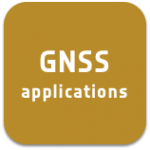If you wish to contribute or participate in the discussions about articles you are invited to contact the Editor
Category:Space Applications: Difference between revisions
No edit summary |
Rui.Pereira (talk | contribs) No edit summary |
||
| (One intermediate revision by the same user not shown) | |||
| Line 7: | Line 7: | ||
On this page you will find all GNSS Applications belonging to the Space Applications category related articles on Navipedia. | On this page you will find all GNSS Applications belonging to the Space Applications category related articles on Navipedia. | ||
GNSS systems were originally designed for earth-based positioning and navigation. Despite this, real-time spacecraft navigation based on | GNSS systems were originally designed for earth-based positioning and navigation. Despite this, real-time spacecraft navigation based on spaceborne GNSS receivers is becoming a common technique for low-Earth orbits and geostationary orbits, allowing satellites to self-determine their position using GNSS, reducing dependence on ground-based stations. | ||
The space community started experimenting with spaceborne receivers very early in the deployment of the GPS network.The first spaceborne GNSS receiver was deployed in Landsat 4 in July 16<sup>th</sup> 1982. The GPSPAC receiver deployed with Landsat 4 was also deployed with Landsat 5 and 2 other US Department of Defense missions and despite the few number of GPS satellites deployed (at that time only 6 Block I satellites were deployed), the GPSPAC was able to demonstrate the feasibility of using GNSS for space navigation. | |||
The full introductory article can be read [[Space Applications|here]]. | The full introductory article can be read [[Space Applications|here]]. | ||
Latest revision as of 00:43, 9 September 2011
DescriptionOn this page you will find all GNSS Applications belonging to the Space Applications category related articles on Navipedia. GNSS systems were originally designed for earth-based positioning and navigation. Despite this, real-time spacecraft navigation based on spaceborne GNSS receivers is becoming a common technique for low-Earth orbits and geostationary orbits, allowing satellites to self-determine their position using GNSS, reducing dependence on ground-based stations. The space community started experimenting with spaceborne receivers very early in the deployment of the GPS network.The first spaceborne GNSS receiver was deployed in Landsat 4 in July 16th 1982. The GPSPAC receiver deployed with Landsat 4 was also deployed with Landsat 5 and 2 other US Department of Defense missions and despite the few number of GPS satellites deployed (at that time only 6 Block I satellites were deployed), the GPSPAC was able to demonstrate the feasibility of using GNSS for space navigation. The full introductory article can be read here. |
Pages in category "Space Applications"
The following 4 pages are in this category, out of 4 total.
